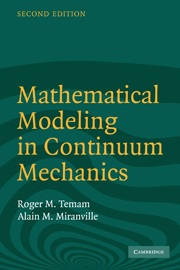Book contents
- Frontmatter
- Contents
- Preface
- A few words about notations
- PART I FUNDAMENTAL CONCEPTS IN CONTINUUM MECHANICS
- PART II PHYSICS OF FLUIDS
- 7 General properties of Newtonian fluids
- 8 Flows of inviscid fluids
- 9 Viscous fluids and thermohydraulics
- 10 Magnetohydrodynamics and inertial confinement of plasmas
- 11 Combustion
- 12 Equations of the atmosphere and of the ocean
- PART III SOLID MECHANICS
- PART IV INTRODUCTION TO WAVE PHENOMENA
- Appendix: The partial differential equations of mechanics
- Hints for the exercises
- References
- Index
11 - Combustion
Published online by Cambridge University Press: 06 July 2010
- Frontmatter
- Contents
- Preface
- A few words about notations
- PART I FUNDAMENTAL CONCEPTS IN CONTINUUM MECHANICS
- PART II PHYSICS OF FLUIDS
- 7 General properties of Newtonian fluids
- 8 Flows of inviscid fluids
- 9 Viscous fluids and thermohydraulics
- 10 Magnetohydrodynamics and inertial confinement of plasmas
- 11 Combustion
- 12 Equations of the atmosphere and of the ocean
- PART III SOLID MECHANICS
- PART IV INTRODUCTION TO WAVE PHENOMENA
- Appendix: The partial differential equations of mechanics
- Hints for the exercises
- References
- Index
Summary
The objective of this chapter is the study of mixtures of reactive gaseous or liquid fluids, that is to say fluids undergoing chemical reactions (fuel, oil and oxygen, various chemical species, etc.). The equations and models that we present are commonly used nowadays for the study of phenomena as different as the propagation of chemical pollution in the atmosphere or in water (seas, rivers, estuaries) or the combustion of mixtures of fuel, oil, and oxygen in cars, planes, or rocket engines. The number N of chemical species taken into account can vary from a few units to several hundreds.
We start, in Section 11.1, by describing the framework for mixtures of nonnecessarily reactive fluids. Section 11.2 is devoted to the equations of chemical kinetics. We then formulate in Section 11.3 the general equations of combustion and describe a typical problem of combustion. In Section 11.4, we introduce the Stefan–Maxwell equations corresponding to an even more complex problem of chemical kinetics and combustion. Finally, we finish, in Section 11.5, with an overview of the case in which the mixture only contains two chemical species; although much simpler, this case already leads to very complex mathematical problems that we will be only able to describe briefly.
Equations for mixtures of fluids
We consider in this section a mixture composed of N different miscible species.
- Type
- Chapter
- Information
- Mathematical Modeling in Continuum Mechanics , pp. 172 - 184Publisher: Cambridge University PressPrint publication year: 2005

